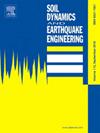Vibration of inclined piles in transversely isotropic soils
IF 4.2
2区 工程技术
Q1 ENGINEERING, GEOLOGICAL
引用次数: 0
Abstract
This paper studies the dynamic behavior of inclined piles in transversely isotropic soils using a hybrid analytical-numerical approach. Inclined piles subjected to various vibration modes are modeled using the three-dimensional dynamic Bernoulli-Euler beam theory. The dynamic interaction between the inclined piles and the surrounding transversely isotropic soil is represented by a series of rigid radiation discs defined at the nodal points of the beam elements. The Green's functions governing the dynamic response of the radiation discs embedded in the transversely isotropic medium are derived using complete potential functions. The Green's functions fully satisfy the regularity conditions at infinity, eliminating the spurious wave reflections within the domain, addressing a major challenge in most numerical methods for dynamic soil-pile interactions. The dynamic impedance functions for inclined piles are determined, and the coupled influence of various parameters, including pile inclination angle, soil anisotropy, and excitation frequency on the dynamic pile-soil interaction is highlighted. The dynamic interaction factors for inclined piles embedded in transversely isotropic soils are also presented, essential for the design and analysis of pile groups subjected to vibrations.
横向各向同性土中斜桩的振动
本文采用解析-数值混合方法研究了横向各向同性土中斜桩的动力特性。采用三维动力伯努利-欧拉梁理论对不同振动模式下的斜桩进行了建模。斜桩与周围横向各向同性土体之间的动力相互作用由一系列在梁单元节点处定义的刚性辐射盘来表示。利用完全势函数导出了控制横向各向同性介质中辐射盘动态响应的格林函数。格林函数完全满足无穷远处的规则性条件,消除了域内的杂散波反射,解决了大多数土桩动力相互作用数值方法的主要挑战。确定了斜桩的动力阻抗函数,重点分析了桩倾角、土体各向异性、激励频率等参数对桩土动力相互作用的耦合影响。本文还研究了横向各向同性土体中斜桩的动力相互作用因素,这对群桩的振动设计和分析至关重要。
本文章由计算机程序翻译,如有差异,请以英文原文为准。
求助全文
约1分钟内获得全文
求助全文
来源期刊

Soil Dynamics and Earthquake Engineering
工程技术-地球科学综合
CiteScore
7.50
自引率
15.00%
发文量
446
审稿时长
8 months
期刊介绍:
The journal aims to encourage and enhance the role of mechanics and other disciplines as they relate to earthquake engineering by providing opportunities for the publication of the work of applied mathematicians, engineers and other applied scientists involved in solving problems closely related to the field of earthquake engineering and geotechnical earthquake engineering.
Emphasis is placed on new concepts and techniques, but case histories will also be published if they enhance the presentation and understanding of new technical concepts.
 求助内容:
求助内容: 应助结果提醒方式:
应助结果提醒方式:


